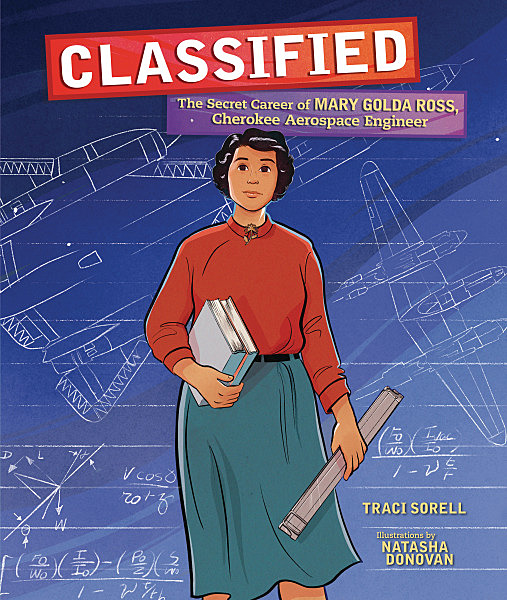 Classified: The Secret Career of Mary Golda Ross, Cherokee Aerospace Engineer
Classified: The Secret Career of Mary Golda Ross, Cherokee Aerospace Engineer
Written by Traci Sorell
Illustrated by Natasha Donovan
Millbrook Press, 2021, 32 pp (unpaged)
ISBN: 9781541579149
Cherokee author Traci Sorell begins the amazing life story of Mary Golda Ross (1908-2008) with a note that describes these four Cherokee values: “gaining skills in all areas of life (both within and outside of the classroom), working cooperatively with others, remaining humble when others recognize your talents, and helping ensure equal education and opportunity for all.” Each of these values is exemplified in Mary’s life.
Mary Golda Ross’s great-grandfather John Ross, who had served as the Principal Chief of the Cherokee Nation, created the school that 16-year-old math-whiz Mary attended. She graduated and taught high school math and science. Later, she served as a girls’ adviser at the Santa Fe, New Mexico, Bureau of Indian Affairs (BIA) boarding school where she continued to encourage girls to learn. This story addresses the obstacles that Indigenous people and women encountered in pursuing formal education.
During World War II, Mary landed a position with Lockheed Aircraft based on her skills in mathematics. Following the war, when she wanted to help design and build aircraft and spacecraft, she studied to be an engineer and was hired as Lockheed’s first female engineer. In 1953, she joined Lockheed’s top-secret Skunk Works division with the mission of “taking the theoretical and making it real.” Mary collaborated on an aerospace team that developed satellites and technology to assist astronauts in landing on the moon. Her contributions were not acknowledged during her lifetime.
Throughout her life she encouraged others, especially young women, to study and excel as engineers. “Do the best you can and search out available knowledge and build on it. I started with a firm foundation in mathematics and qualities that came down to me from my Indian heritage” (Mary Golda Ross, April, 2008). Pursuing knowledge, engaging in teamwork, practicing humility, and providing opportunities for others—her Cherokee values—framed her life.
The book’s backmatter includes two photographs of Mary and a timeline of her life and accomplishments. In 2004, at the age of 96, she participated in the Native Nations Procession when the National Museum of the American Indian opened in Washington, DC. In 2019, her work in the space program was commemorated when she was selected as an honoree for a U.S. Native American dollar for her work in the space program. Classified was named an Orbis Pictus Honor Book and an American Indian Library Association (AILA) American Indian Youth Literature Award Honor Book.
Natasha Donovan’s illustrations were created with pencil, ink, and Procreate software. Her bold double-page artwork completes the text and makes the book an effective read-aloud selection as well as a choice for independent reading and researching. Many of Natasha’s illustrations include STEM activities—from mathematical equations to drawings of various aircraft to images of the moon landing. The artwork also shows Mary working on all-male teams.
Educators sharing this book with young people may need to stress the barriers most Indigenous women experienced as they tried to participate in formal education, particularly in the 20th century. Despite her obvious brilliance, Mary Golda Ross’s success was not assured. Her job at the BIA school may deserve an expanded conversation and perhaps some research on the part of readers.
In addition to being paired with other books in this WOW Review issue, Classified can be paired with other biographies of women, particularly those focused on the achievements of Indigenous women. These titles can make a powerful text set: Ella Cara Deloria: Dakota Language Protector by Diane Wilson (2021), Sharice’s Big Voice: How a Native Kid Becomes a Congresswoman by Sharice Davis with Nancy K. Mays (2021), She Persisted: Wilma Mankiller by Traci Sorell (2021), She Persisted: Maria Tallchief by Christine Day (2021), She Persisted: Deb Haaland by Laurel Goodluck (2023), and The Water Lady: How Darlene Arviso Helps a Thirsty Navajo Nation by Alice B. McGinty (2021).
Classified can also be paired with other picturebooks that focus on Cherokee culture, such as When We Gather (Ostadahlisiha): A Cherokee Tribal Feast written by Andrea L. Rogers (Cherokee Nation) and illustrated by Madelyn Goodnight (Chickasaw) (2024). Nonfiction titles that accurately portray Cherokee people and culture, past and present, can also help readers build or extend their background knowledge before or after reading this book.
Traci Sorrell is an award-winning author and enrolled member of the Cherokee Nation. She writes historical and contemporary fiction and nonfiction in a variety of formats for young people. Her book We Are Grateful: Otsaliheliga (2018) was named a 2019 Sibert Honor Book and Orbis Pictus Honor Book. Traci lives in Oklahoma. Readers can learn more about her work on her website.
Illustrator Natasha Donovan grew up in Vancouver, British Columbia. She is Métis and currently lives in Washington State. Natasha illustrated the graphic novel Surviving the City, written by Tasha Spillitt (2018). Their book earned an AILA American Indian Youth Literature Honor Award. See more of her work on her website.
Judi Moreillon, Tucson, AZ
© 2024 by Judi Moreillon

WOW Review, Volume XVI, Issue 4 by Worlds of Words is licensed under a Creative Commons Attribution-NonCommercial-ShareAlike 4.0 International License. Based on work by Judi Moreillon at https://wowlit.org/on-line-publications/review/xvi-4/7/
WOW review: reading across cultures
ISSN 2577-0527
